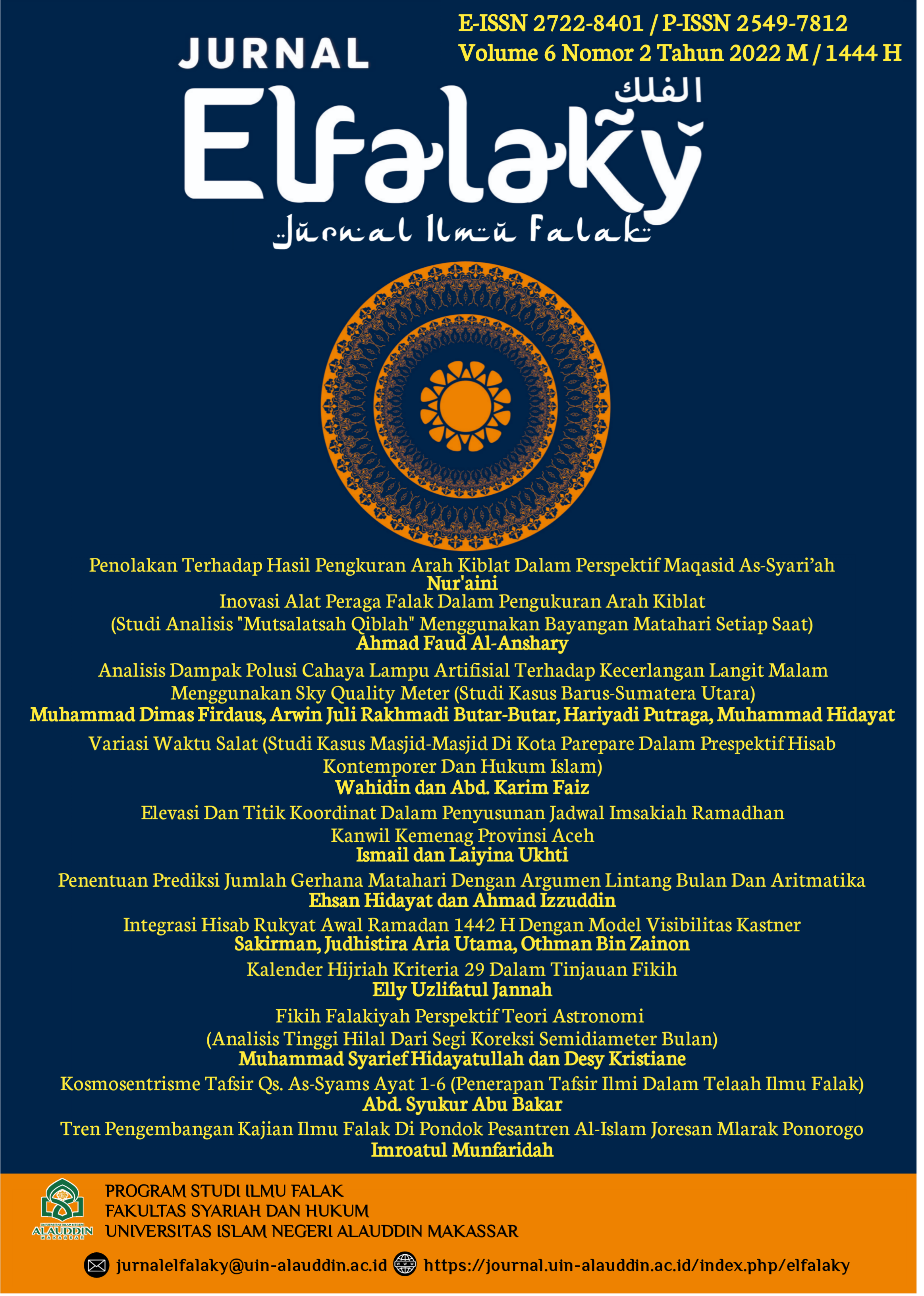KOSMOSENTRISME TAFSIR QS. AS-SYAMS AYAT 1-6: PENERAPAN TAFSIR ILMI DALAM TELAAH ILMU FALAK
Abstract
The contents of the Qur'an are full of cosmocentrism dimensions that elaborate on various phenomena of the universe in it. Normative theological cues that Allah swt. convey to QS. as-Shams verses 1-6 is one of the illustrations of the Qur'an that directs humans to understand themselves by referring to various phenomena of the universe because reading the universe is an inseparable part of reading the verses of Kauniyah in addition to reading the verses qauliyah written in the Qur'an so that scientific interpretation becomes one of the appropriate interpretation approaches in its interpretation. Humans are creatures who have been equipped with various potentials, both empirical senses and rational reason, so that they are always directed to observe and reason a lot about cosmocentric universe phenomena. QS. as-Shams verses 1-6 describe how the sun, moon, day, night, sky, and earth with all the sunnatullah framework that accompanies it become one of the objects of study of astronomy which has many epistemological intersections with various cosmocentric universe phenomena through scientific interpretation.
References
Afida, Anisa Nur dkk., “Matahari dalam Perspektif Sains dan al-Qur’an”, Indonesian Journal of Science and Mathematics Education Vo..02 No. 01 (2019)
Ahmad Fuad Pasya, Dimensi Sains al-Qur’an: Menggali Ilmu Pengetahuan dari al-Qur’an, Solo: Tiga Serangkai, 2006.
Azhari, Susiknan, Ensiklopedi Hisab Rukyah, Yogyakarta: Pustaka Pelajar, 2008.
Basir, Fatur Rahman dan Muh. Rasywan Syarif, “Periodisasi Penciptaan Alam Semesta Dalam Manuskrip Kutika dan Science Islam”, ELFALAKY 5, no. 1 (2021).
Fikri, Mursyid dan Muh. Rasywan Syarif, “Eksplorasi Pemikiran Abu Ma‟shar Al Falaky Tentang Manusia dan Bintang”, ELFALAKY 3, no. 2 (2019).
Haris, Achmad Murtafi, Korelasi al-Qur’an dan Filsafat tentang Asal Alam Semesta, https://www.nu.or.id. (23 Agustus 2022)
Hasan, Muhammad, “Benda Astronomi dalam al-Qur’an dari Perspektif Hadits”, Jurnal Teologia Vol. 26 No. 01, (Januari-Juni 2015)
Ichwan, Mohammad Nor, Tafsir ‘Ilmiy: Memahami al-Qur’an melalui Pendekatan Sains Modern, Jogjakarta: Penerbit Menara Kudus, 2004.
Jidi, La, “Peranan Sains dalam Mengenal Tuhan” Jurnal Dakwah Tabligh Vol. 14 No. 2 (Desember 2013)
Kartikasari, Yasmin, “Alam, Manusia, dan Spiritualitas”, Jurnal Sosioteknologi Edisi 24 Tahun 24 (Desember 2011)
Khaeruman, Badri, Sejarah Perkembangan Tafsir al-Qur’an, Bandung: Pustaka Setia, 2004.
Mahmood, Sultan Bashir, The Miraculous Qur’an: A Challenge to Science and Mathematics, Islamabad: Dar al-Hikmah International, 2020.
Mujab, Sayful dan M. Rifa Jamaludin Nasir, “Ilmu Falak: Dimensi Kajian Filsafat Ilmu”, Jurnal al-Afaq Vol. 2 No. 2 (Desember 2020)
Purwanto, Agus, Ayat-Ayat Semesta: Sisi-Sisi al-Qur’an yang Terlupakan, Bandung: Mizan, 2008.
Qutub, Sayyid, Tafsir fi Zilal al-Qur’an, Vol. 8, Terj. As’ad Yasin dkk., Jakarta: Gema Insani, 2004.
as-Sa’di, Syaikh Abdurrahman bin Nashir, Tafsir al-Qur’an, Jakarta: Darul Haq, 2019.
Sani, Ridwan Abdullah, Sains Berbasis al-Qur’an, Jakarta: Bumi Aksara, 2014.
Shihab, Quraish, Tafsir al-Misbah, Vol. 4, Jakarta: Lentera Hati, 2006.
______, Tafsir al-Misbah, Vol. 15, Jakarta: Lentera Hati, 2002.
Sufiana dan M. Karman, Ulumul Qur’an dan Pengenalan Metode Tafsir, Bandung: Pustaka Islamika, 2002.
Syarif, Muh. Rasywan. Ilmu Falak Integrasi Agama dan Sains. Cet.I; Gowa: Alauddin University Press, 2020.
Watini, Sri dan Viola Tashya Devana, “Teori Kuantum Baru yang Sesuai Sains dan Teknologi dengan Kaidah Hukum Islam” ADI Bisnis Digital Interdisiplin Journal 2 (Juni 2021)
Zaini, Muhammad, “Alam Semesta menurut al-Qur’an”, Tafse: Journal of Qur’anic Studies Vol. 3 No. 1 (Januari-Juni 2018)





